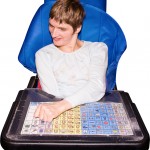
Multi-sensory story telling is one way that adults with profound and multiple learning disabilities can make sense of who they are and what is happening in their day to day lives. The books used are individualised stories which, in addition to verbal text, also involve sensory stimulation. The approach is gaining in popularity, but as yet there is little in the literature to inform practice.
We posted earlier in the year about a small study looking at the impact of multi-sensory storytelling on staff-client interactions. The researchers had expected the individualised approach to provide the optimum setting for high quality interaction, and were surprised to find only moderate scores on the interactive style dimensions of the measurement scale they used.
The researchers in this current study were interested to look at the development, content and practical application of the books for people with profound and multiple learning disabilities.
They worked with 49 people described as having profound learning disabiliteis and their direct support staff.. The researchers looked at the use of the books in detail, in particular whether or not the guidelines to their use were being followed.
They found that 84% of the books were constructed according to guidelines. However, they also found that the story was read as intended in only 1.3% of the sessions
Regarding content, 67.4% of the stories focused on daily life excursions.
In terms of the stimuli used, they found that tactile stimuli were most commonly used.
They conclude from this study that most books were properly constructed but that guidelines were not really well followed during reading. They point out that this will negatively influence the effectiveness and individual outcomes.
Multi-sensory Storytelling for Persons with Profound Intellectual and Multiple Disabilities: An Analysis of the Development, Content and Application in Practice, ten Brug, A.,et al., in Journal of Applied Research in Intellectual Disabilities, 25: 350–359.
